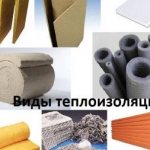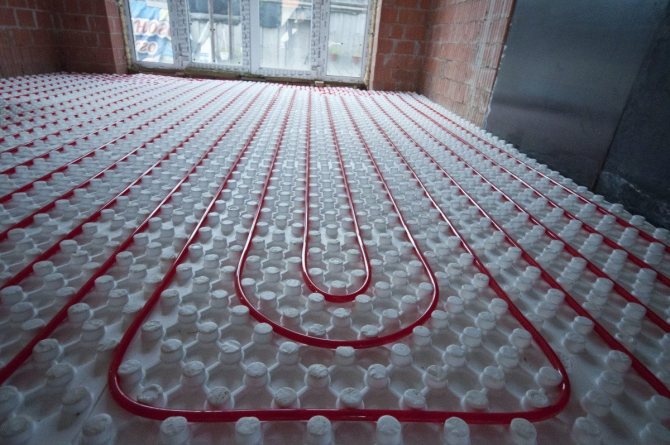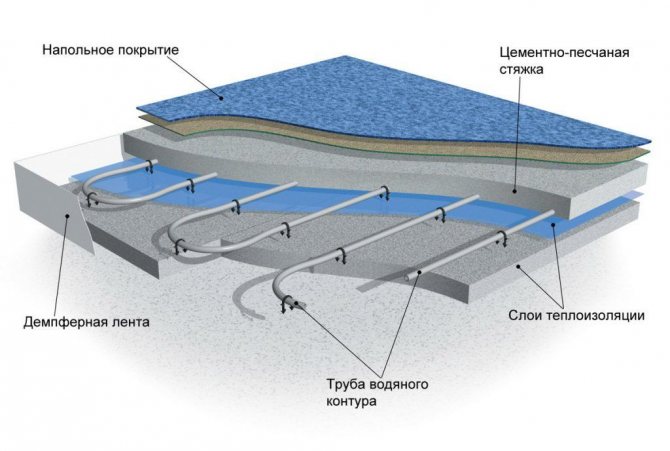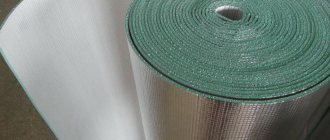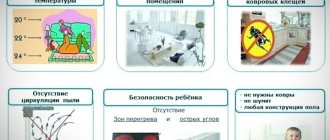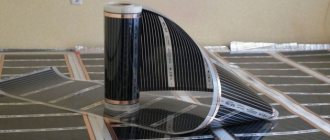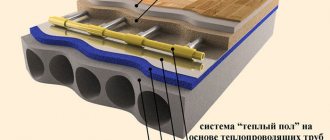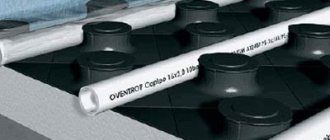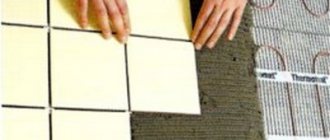To make the indoor climate as comfortable as possible for living, special attention should be paid to high-quality thermal insulation of the enclosing structures. Poorly insulated floors can cause significant heat loss and condensation, which is an ideal breeding ground for mold and mildew. Today, expanded polystyrene for underfloor heating is considered one of the most modern and reliable methods of thermal insulation.
Expanded polystyrene
A good quality heat insulator should have a number of the following qualities:
- Ecological cleanliness,
- Resistant to moisture,
- Ease of installation,
- Maximum seamlessness,
- Resistance to temperature extremes,
- High-quality sound insulation,
- High resistance to compression and cracking,
- Non-flammability.
Modern heaters can be divided into two groups:
Insulation for warm water floor
- Heaters consisting of mineral fibers (glass wool and mineral wool). They are made in the form of mats, plates and rolls.
- Heaters consisting of foamed materials (polystyrene, polyurethane foam, polypropylene foam, polyethylene foam and polystyrene for underfloor heating). They are made in the form of panels, blocks and slabs.
Selection Tips
To make the choice of a material that will justify the money spent on it, you need to pay attention not only to the characteristics of the raw material and its parameters, but also to the operational life of the material. ... Many types of products with high performance and properties, unfortunately, have a short service life.
As a result, the replacement of the thermal insulation material with a new one will need to be carried out much earlier than the prevention of any elements of the underfloor heating system is required. This is especially true for floors where the coating is made with tiles, for example, in the bathroom, as a result of which it will be necessary to dismantle the products. Therefore, the minimum period for floor insulation products should be 10-15 years.
Many types of products with high performance and properties, unfortunately, have a short service life. As a result, the replacement of the thermal insulation material with a new one will need to be carried out much earlier than the prevention of any elements of the underfloor heating system is required. This is especially true for floors where the coating is made with tiles, for example, in the bathroom, as a result of which it will be necessary to dismantle the products. Therefore, the minimum period for floor insulation products should be 10-15 years.

As for the properties of the material, which are worth paying attention to in the first place, the following should be highlighted:
- coefficient of thermal conductivity;
- level of resistance to mechanical stress;
- resistance to dynamic influences;
- vapor permeability;
- hygroscopicity;
- density of the material.
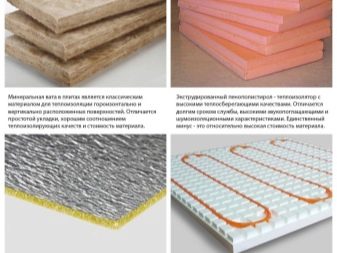

For rooms with high ceilings, the height of which exceeds 250 cm, you can opt for durable insulation with a rigid polymer base. For wood floors, it is best to purchase an environmentally friendly and non-combustible material. Mineral wool may be a good option for thermal insulation in this case. For floors where the heating system is equipped with a cable, the main property of the insulation is the presence of a heat-reflecting layer, regardless of the form in which the material will be made.
Choosing a substrate for a warm water floor
Expanded polystyrene for underfloor heating
Underfloor heating substrate purpose and varieties
Expanded polystyrene is produced in sheets, it is easy to install it on the base of the floor. The thickness of the slabs varies from 30 to 120 mm. The greatest thickness of the foam plastic slabs should be taken when there is an unheated basement under the floor. A slab thickness of 30 mm is mounted if a heated room is located under the ceiling. Expanded polystyrene must be protected from moisture penetration with a waterproofing film.
The disadvantages of foam include the low strength of the material. Due to the fragility and low strength of expanded polystyrene, when installing a concrete screed, it is necessary to reinforce the heat-insulating layer. The advantages of the material include the low cost, thanks to which the foam plates have become the most popular insulation, like Knauf underfloor heating in our country.
Mineral mats for underfloor heating
Laying insulation under a warm floor
The advantages of mineral wool include the ability of the material to fill the entire space, ensuring the solidity of the heat-insulating layer. The disadvantages of mineral wool include high hygroscopicity. Mineral mats tend to absorb moisture and lose their properties. The mineral wool layer needs high-quality vapor barrier, which is not always possible to provide at a high level on its own.
For underfloor heating, you can use mineral insulation from various manufacturers. In the line of popular brands there are types of basalt and fiberglass heaters that can withstand serious loads, which are designed to insulate floors in a house on screw piles, insulate floors on the first and basement floors.
Cork insulation for underfloor heating
Wax-impregnated cork insulation
To insulate the base under the "warm floor", you can use cork insulation impregnated with wax. The material is mounted on adhesives. The disadvantages of cork insulation include sensitivity to moisture and biological destruction. Before laying, care should be taken to ensure a reliable seal and vapor barrier.
Insulating the floor with a cork, laying agglomerate panels under the flooring is a good way to reduce heat loss at home. Although cork panels are inferior in terms of heat saving to synthetic materials, they are quite appropriate.
Choosing the best insulation for a warm floor.
Profile heat-insulating mats
Insulation for a warm floor. Profile mats
Profile mats are designed for water-type floor heating systems. They provide reliable thermal insulation of the floor and are covered with a vapor barrier membrane. This removes some of the problems in the form of the need for additional installation of the vapor barrier. On the surface of the heat-insulating mats there are protrusions designed for laying and fixing the flexible pipes of the water-heated floor system.
The main task of the heat-insulating layer is to direct the thermal energy strictly upward, that is, to the room for which heating is required. The thermal insulation layer prevents heat penetration through the lower floor slab.
Features of laying the thermal insulation layer
Styrofoam plates are laid on a base that has been previously cleaned of debris and leveled with appropriate solutions. Next, waterproofing is laid on the base of the floor, and on top of it - expanded polystyrene plates. If a plate without bosses is used, then a metal or plastic mesh is laid on the thermal insulation, to which the cable or pipes of the water-heated floor will be attached.
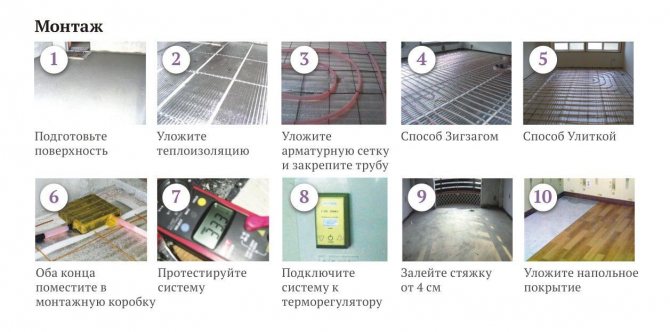

Stages of installation of a water-heated floor
The last stage in the arrangement of the heating system is the filling of a cement-sand screed, which contributes to an even distribution of heat.
Companies producing expanded polystyrene for underfloor heating claim that this material can last 50 years.However, tests carried out by scientists have shown that a warm floor laid on expanded polystyrene plates will function reliably for more than 60 years. And if we add to these factors the affordable cost of materials, we can say that foam is an ideal insulation not only for underfloor heating systems, but also for various types of finishing work.
Using foam to insulate the screed
The cost of installing a water-heated floor and the installation process
Floor insulation with foam plastic under the screed is one of the types of floor insulation.
In order to form a heat-insulating layer, PSB-S-35 is used. To make the joining of the slabs tighter, slabs with milling edges are used.
Before using polystyrene, you need to create a polyethylene flooring. It will promote isolation.
The foam is not strong enough to withstand the load of the concrete screed. In order to reduce the load, a dense mounting mesh with a thickness of 40-60 mm is used.
Instructions for the formation of insulation:
- The dense lower backing is covered with plastic wrap.
- Styrofoam plates are tightly placed around the entire perimeter. The joints are filled with polyurethane foam or firmly glued.
- A mesh is installed over the insulation.
- A screed is arranged on top. Its composition can be different, the basis is concrete.
With the correct flooring and the absence of excess ventilation, the temperature in the entire room, including on the floor, will be the same. After the screed is completely dry, cover. Complete drying time - at least 28 days.
There are several more commandments of forming a warm floor under a screed, which cannot be violated:
- Insulation of the floor with foam plastic must correspond to the parameters of the room. Since the width of the foam and the screed takes up some of the height of the room, there is no need to create too wide a layer where it is not necessary. For interroom floors, a slab 2-3 cm thick is sufficient.
- For a more fragile type of insulation, a large layer of screed is used - 5 cm, for a more durable insulation, a layer of 4 cm can be used.
- Do not forcibly dry the surface. The process should take place naturally in the absence of drafts and the presence of constant moisture.
- When mixing the solution, the proportions must be strictly observed.
Floor insulation
How to fix the building material?
When installing underfloor heating, experts recommend using several mounting methods:
- it is the reinforcing mesh that is most often used. This method of fixing expanded polystyrene is more suitable for a water system, but can be used when laying an electrical cable. Where there are bends of heating elements, 2 screeds will be enough, in some places a maximum of three screeds are used. The method is considered the easiest. Of course, one must take into account that the process itself is laborious, but there are enough specialists in Moscow who can easily cope with all the tasks set;
- it is also possible to fasten the material with the help of plastic guides that fit on polystyrene foam, but only if it has a smooth surface. Such fasteners may differ in size, and they are attached if they are inserted one into one. Such installation can be done quickly enough, while the fixation will be reliable. The only drawback is that it is difficult to mark up, since there is no grid;
- most often slabs with bosses are used, such a building material by itself will be able to solve the issue with fasteners, because the bosses are clamps. Naturally, such plates will cost more than other similar materials, but their quality is also high.
We recommend: How does an underfloor heating water heater work?
Expanded polystyrene is such a material that even a beginner can work with. You just need to choose all the necessary material for floor insulation and do all the work yourself, otherwise you can invite specialists.
- Similar posts
- How to install a warm floor on a wooden floor?
- What kind of warm floor to lay under the parquet board?
- How to install a water-heated floor under the tiles?
- What kind of substrate is needed for a laminate for a warm water floor?
- How to install a water-heated floor?
- How much does a warm floor consume?
What is expanded polystyrene plates
How to install a mixing unit for a warm floor with your own hands
The term "expanded polystyrene" means a material made by foaming polystyrene. Plates made from it are the final product for thermal insulation.
The main advantages of expanded polystyrene are its small thickness, light weight, ease of installation and affordable cost.
Important! When installing underfloor heating using slabs, it is necessary to take into account the load and distribute it correctly!
The advantages of expanded polystyrene for underfloor heating include:
- High heat retention rates. Its thermal conductivity coefficient is much lower than that of polystyrene, which makes it possible to lay slabs of lesser thickness.
- Good indicators of mechanical strength make it possible to use it as a structural element for loaded structures, a reinforcing layer and an underlying layer.
- The thermal stability of expanded polystyrene makes it possible to use it regardless of temperatures.
- Expanded polystyrene plates easily tolerate the effects of chemicals and the unfavorable environment of the external environment.
- In the manufacture of plates, shapes can be used that form the so-called bosses, serving as protrusions for laying between them a heating element (tube), the diameter of which can be from 16 mm to 18 mm.
- The presence of side locks makes it possible to form panels from slabs without "gaps", which in turn provides sufficient adhesion and avoids seams that give thermal acoustics.
- Excellent performance in sound insulation.
- Environmentally neutral and does not pose a threat to the human body.
- Absolutely resistant to microorganisms and fungi. Its synthetic base is a reliable barrier to putrefactive processes that can occur on other materials of heat-insulating materials during operation.
- Moisture resistance is the main advantage of the material. Even with constant ingress of moisture on the plates, it will not deform.
- Underfloor heating, laid on polystyrene foam plates, will not cause harmful vapors from heating the material, since its granules are carbon and hydrogen.
- Vapor barrier performance is provided by air capsules in expanded polystyrene foam. They are usually practically closed and impermeable. Therefore, neither air nor steam can pass through the material. This is a wonderful vapor barrier that cannot accumulate moisture inside itself.
These advantages of the material became the starting point for the construction of floors, including warm ones.
Benefits of expanded polystyrene
Expanded polystyrene board, in comparison with other types of heat-insulating materials, has a number of advantages.


Layout diagram of the warm floor device
- Ease of delivery and stacking. Due to the low weight of the slab, the insulation can be independently delivered to the destination. The foam can be cut without effort. The plates are easily joined together. However, in order to avoid the penetration of moisture and the formation of cold bridges during the operation of the underfloor heating system, all joints must be glued with mounting tape.
- The polystyrene board has a very low coefficient of thermal conductivity, therefore, even by laying thin foam plastic that does not significantly affect the floor height, high thermal insulation performance can be achieved.
- The expanded polystyrene plate does not burn, so it can be safely used as a heat-insulating material not only when arranging a water-heated floor, but also when installing an electric heating option.

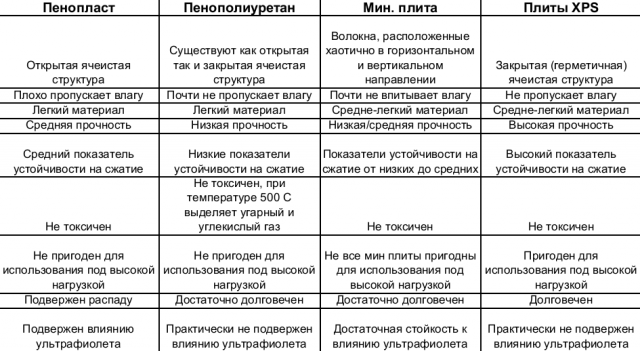
Comparative table of various characteristics of heaters - Polyfoam has a special composition that prevents the formation of mold and other fungi.
- The polystyrene board is not exposed to chemicals.
- This material is environmentally friendly, therefore, when using it, the development of allergic reactions is excluded. Even with strong heating, it does not emit harmful substances into the air.
Features of thermal insulation of heated floors
The laying of heat-insulating materials for a warm water floor should be carried out after a number of basic preparatory measures, represented by the dismantling of the old coating and high-quality preparation of the base for the insulation flooring. The modern "warm floor" system is not capable of fully functioning without the use of a sufficient layer of high-quality insulation.
During the operation of underfloor heating in the presence of unsatisfactory insulation, the formation of very characteristic "cold bridges" is noted, which negatively affects the heating of the room and is accompanied by significant thermal energy leaks.
As a result, the cost of money for paying energy bills is sharply increasing.
The advantages of the water "warm floor" system include the possibility of self-assembly, a wide price range for the materials used, getting the fastest and most uniform heating, providing a comfortable tactile floor covering and the absence of even a minimal risk of electrical injury during operation.
When arranging the system, it is necessary to take into account the rather high cost of all components with the highest thermal conductivity coefficient, as well as the limited choice of materials for finishing.
One of the main advantages of the “warm floor” system, properly equipped with the use of high-quality insulation, is the economy of energy consumption, which, depending on the area of the heated room, can vary within 10-70%. Any violations during the installation of such a system, as well as a complete neglect of thermal insulation, minimize efficiency and do not allow the room to be optimally heated to comfortable temperature indicators.
Popular types of expanded polystyrene
Polyfoam, as a rule, is produced in the form of slabs. The most popular among consumers are polystyrene foam boards of the following types:
- pressless;
- extruded;
- foil;
- profile.


Heat insulating material for warm floors
In the production of expanded polystyrene, various technologies are used that determine its characteristics, areas of application and methods of installation.
Pressless expanded polystyrene
The process of manufacturing this type of material is that polystyrene granules are placed in hot water, and after swelling, they are dried and foamed, placed in special molds or an extruder.


Types of non-pressed polystyrene foam
Given the low cost of production, such foam is distinguished by a very democratic cost, and therefore is especially popular among citizens who are puzzled by the installation of a warm water floor.
Extruded polystyrene foam
Polyfoam belonging to this variety is obtained by mixing polystyrene granules with a blowing agent under pressure and at a high degree of heating.The result is a viscous mass, which is extruded using a special tool equipped with an extrusion head.
Laying extruded polystyrene foam
Extruded polystyrene foam for underfloor heating is especially popular among installers who install water-based systems. Slabs made of this material are also widely used in other areas of construction, for example, when insulating roofs, foundations and facades of houses.
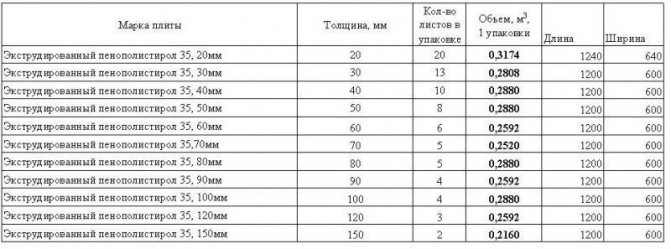

Extruded Polystyrene Foam Size Chart
Foil polystyrene foam
Such foam has a distinctive feature that is the presence of an additional metallized layer. This material is often used in underfloor heating systems, as the foil layer acts as a reflector, increasing heating efficiency by distributing heat evenly.
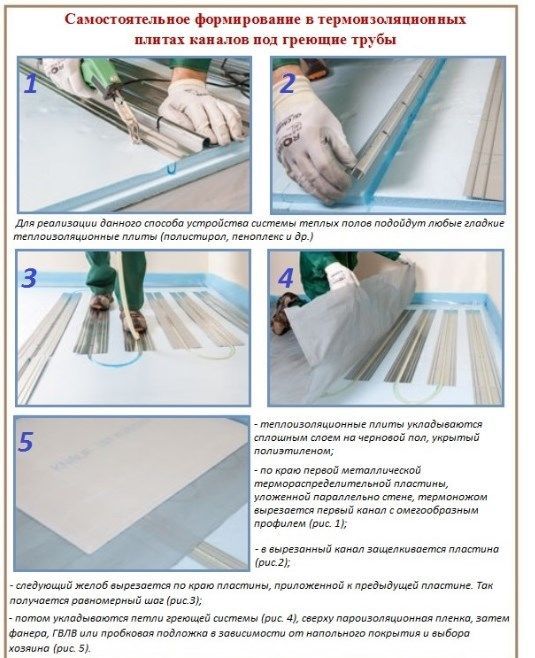

Step-by-step installation of foil polystyrene foam on a warm floor
When arranging a warm water floor, it is always necessary to lay an additional layer of foil under the pipeline, which acts as a reflector. The use of foamed polystyrene foam eliminates this need.
However, when laying it, it must be borne in mind that the concrete screed in which the system is placed, in a short period of time completely corrodes the thin layer of aluminum with which the slabs are covered. Therefore, this material must be protected with an additional layer of waterproofing.
It should be noted that foil-clad polymer insulation can be used when arranging a water and cable underfloor heating. But it cannot be used when installing infrared mats.
Profile expanded polystyrene
The use of this material facilitates the work during the installation of the underfloor heating system, as it eliminates the need to lay a reinforcing mesh to which the pipeline is attached, apply markings and install guides, since all these functions are performed by bosses located across the entire surface of the slab.
Distinctive features of such a plate are the following factors:
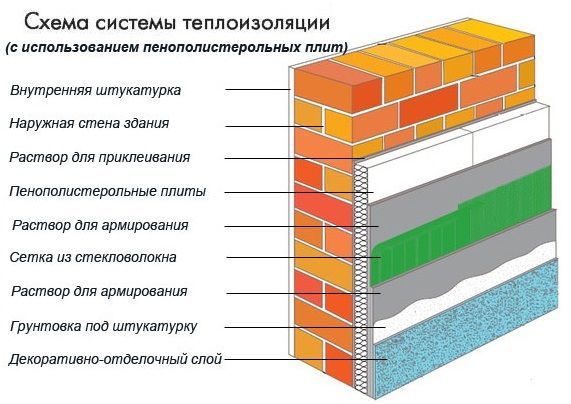

Thermal insulation scheme using expanded polystyrene plates
- the bosses themselves, which allow you to easily lay a water pipeline or an electric underfloor heating cable, regardless of the chosen scheme;
- increased mechanical strength due to the high density of the material;
- the presence of a shell that acts as a vapor barrier that protects against moisture;
- a layer of laminated foil, resistant to chemical attack;
- the presence of locking joints, thanks to which the slabs are laid without gaps;
- the presence of a relief pattern on the underside of the slab, which provides ventilation and smooths out minor irregularities in the base.
Types, their advantages and disadvantages
Today, several types of mats are produced, which differ in the material of manufacture, the method of fixing the pipes, and also the purpose for certain types of premises:
Foil coated mats
They are made of foamed polyethylene. One of the sides of the substrate is covered with foil; when the plates are laid, it is on the outside. Heating pipes are laid on top of the foil side.
In terms of their qualities, the products are suitable for floors that perform the functions of additional heating. Therefore, they are ineffective for heating the floor covering on the ground floor, under which the basement is located.
The disadvantage of this type of mats is a prerequisite for laying a steel frame on which the heating circuit will be attached. In the process, it is necessary to use various fastening elements.
Backing with film
The product consists of 3 layers: expanded polystyrene, foil and polymer film, which performs a protective function. On top of the film, there is a special marking on which the direction is indicated. In this direction, pipes will be installed.Such markings greatly facilitate the process of laying underfloor heating. The heat insulator has a high density, due to which a strong fixation of the fasteners is ensured.
The film positively interacts with the screed solution, so there is practically no risk of cracking. The material is ideal for underfloor heating, serving as the main source of heat. These mats retain heat reliably and are easy to fit.
Flat polystyrene foam
The thickness of the material is 4-5 cm, the density is about 40 kg per 1m3, which provides resistance to deformation. To protect the mats from the aggressive influence of the concrete mixture, a plastic wrap is placed on top of them before pouring the screed. Fastening of pipes to plates is carried out by means of plastic brackets, which are easily attached.
The heat insulator is suitable for systems that perform the functions of the main heating. The main disadvantage of this type of product is that before laying the heating circuit, it is necessary to make markings.
Lug mats
The substrate is made by hydropellant stamping, which results in the formation of bosses - cylindrical protrusions. The products are rectangular slabs, the thickness of which is 1-3.5 cm, and the height is 2-2.5 cm. These protruding elements are placed on the surface of the mat in even rows.
This design provides a fairly simple and quick installation method, ensuring reliable fixation of the pipes and reducing the likelihood of their displacement during the screed pouring. On the side edges of the slabs, there are locking joints, which make it possible to mount the substrate without thermoacoustic seams. This creates a continuous slab surface. Each plate has a ruler that makes it easier to align the mats with each other, thus creating a solid surface of the slabs.
Products with lugs withstand heavy mechanical loads and provide reliable thermal insulation. The thickness of the material allows it to perform a sound-absorbing and sound-insulating function.
The substrate of this type is of 2 types: regular and laminated. Laminated mats have a vapor barrier. This material has one significant drawback - high cost.
Advantages and disadvantages
As discussed above, a foil-coated substrate is an excellent material for saving energy. In addition, foil has a number of advantages, but there are also disadvantages.
| pros | Minuses |
| Does not affect the height of the floor, as the foil material is only 2-10 mm thick. | The high cost is the main disadvantage. |
| It is not difficult to install, so even an inexperienced person can cope with the work. | It is not recommended to take a mineral substrate with a metallized layer for underfloor heating, since toxic substances are released during heating. |
| Has properties of soundproofing and waterproofing. | The use of such a substrate in rooms with high humidity significantly reduces its service life. A foil-coated product with a film is recommended. |
| Withstands heating up to +90 degrees and more. | Dissolves on direct contact with cement. |
| Most of the products with foil are equipped with markings, which simplifies the process of laying the heating elements. | |
| There are models with a sticky layer, this makes installation easier. | |
| Reduces heat loss and promotes even heat distribution. |
It should be noted that the foil-clad product is strong, durable if properly installed and used.
Article Rating
What is the thickness of the foam for insulating the loggia insulation technology
This material is expanded polystyrene in boards, which is created by extrusion. It is ideal if you need to make high-quality and correct insulation of the loggia with penoplex, and it is assumed that you do all the actions yourself.In this case, its excellent insulating characteristics, comparative ease of installation operations will come in handy.
What you need to buy to insulate the loggia with your own hands
Here is a list of consumables that will be needed for the production of work:
- Polystyrene in Penoplex boards. The main insulation layer will be created from it.
- Plasterboard forms an external flat surface. It is also permissible to use gypsum-fiber or glass-magnesite analogs. Any sheet options should be selected taking into account the provision of good moisture resistance.
- Ready-made dry mortar for leveling the floor.
- Vapor barrier film with foil layer.
- Construction foam. It is recommended to purchase only a product that does not contain toluene.
- Guides (rails) and fastening (self-tapping screws) elements.
Do-it-yourself technology for insulating a loggia with penoplex
In each case, the set of techniques will be different. You will have to take into account certain options for decorative design, structural features. But the following algorithm can be used as an example, with the necessary changes made to it:
- All outer layers of the floor and walls are removed.
- Window blocks are mounted. All joints are sealed with construction foam.
- Penoplex is attached to the walls and ceiling using dowels and plastic disc nozzles. Large joints are filled with construction foam. The gaps between the plates are sealed with high-quality tape.
- With the foil side inside the room, a vapor barrier film is attached to them. For this operation, it is necessary to use an adhesive based on polyurethane, which is not capable of damaging the penoplex. The joints between these elements are closed with metallized tape.
- A screed for a loggia can be created from a dry mixture with a thickness of 4-5 cm. It is necessary to leave a technological gap of 0.8-1 cm between it and the walls. It is necessary to prevent the appearance of cracks during temperature fluctuations.
- Wooden beams are installed on the vapor barrier film with attachment to the main part of the wall. They are "sewn up" with drywall.
It is not difficult to be convinced that all the listed operations can be done by any person with his own hands. To exclude possible errors due to lack of previous experience, the following recommendations should be used:
- Different heating and lighting devices, communication means can be installed on the loggia. Appropriate engineering networks are installed prior to finishing works.
- It is not necessary to create a vapor barrier between the foam and the main wall. This solution will stimulate the accumulation of condensation in the corresponding hidden area.
- If wooden slats or other elements of the lathing are hidden in the thickness of the insulating layer, this will impair its effectiveness.
- There is no need to use metal guides for such frames. Such options will create favorable conditions for the penetration of cold into the premises.
How to calculate the thickness of foam boards
You can do a variety of work with your own hands. Including an independent calculation of the thickness of the foam insulation layer is available. To concretize the calculations, we make the following assumptions:
- Building location: Moscow. According to the current standards for this city, the coefficient of thermal resistance of walls in a residential building must be at least 3.14 sq. M. on gr. Celsius / W.
- Main wall: two bricks. Its resistance to heat transfer will be 0.99 sq. M. on gr. Celsius / W.
Thus, for these climatic conditions, it is necessary to improve the existing insulation indicators by the following value: 3.14-0.99 = 2.15 sq. M. on gr. Celsius / W. With a thermal conductivity coefficient of 0.028 foam, the following final plate thickness is required: (2.15 * 0.028) * 100 = 6.02 cm.
If it is inconvenient to make calculations with your own hands, or if there is not enough initial data, then you can use special programs, "calculators". They are posted on specialized sites of penoplex sellers.
Types of thermal insulation
Penofol
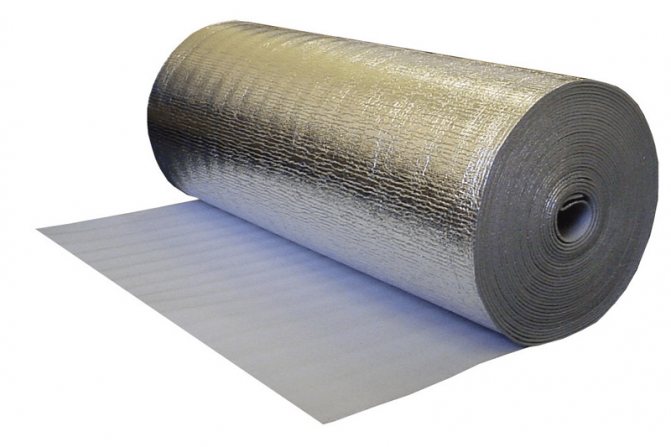

Penofol is produced and sold in rolls.
Penofol is a foil-covered polyethylene foam. It is a soft and flexible material produced in rolls.
Thermal conductivity coefficient - 0.037 - 0.052 W / m × ° С.
Penofol is easy to install, easy to cut. A layer of foil effectively distributes heat over the entire surface of the heated floor.
However, this material also has a drawback: under the weight of the screed and floor covering, it can shrink, while the volume of air bubbles entering its structure will significantly decrease, which will entail a loss of thermal insulation qualities.
Important! As a rule, this material is used on the upper floors of apartment buildings, where there is a warm heated room under the heated floor, and the floor slab is sufficiently heated. ... For basements and first floors, as well as balconies and loggias, basements and garages, this material is not suitable
Sometimes, however, it is not possible to raise the floor a considerable distance, then the use of penofol may be justified.
For basements and first floors, as well as balconies and loggias, basements and garages, this material is not suitable. Sometimes, however, it is not possible to raise the floor a considerable distance, then the use of penofol may be justified.
Advice! When choosing floor insulation, look for foil materials with an aluminum foil thickness of at least 30 microns. We are not interested in lavsanny coatings with reflective properties, only thick foil!
Corkwood


Balsa insulator is sold in rolls, sometimes in the form of mats or slabs.
The thermal conductivity of balsa wood ranges from 0.035 to 0.05 W / m × ° С. As you can see, this characteristic is comparable to that of penofol.
However, it is believed that a 2 - 3 mm thick cork layer is sufficient to insulate a warm floor. This is certainly a controversial opinion.
The advantage of cork insulation is its naturalness. It consists of absolutely natural raw materials and does not emit toxic chemicals under any conditions.
However, there are also disadvantages:
- high material price;
- the possibility of rotting, a breeding ground for fungi and mold;
- damage from biological corrosion;
- the cork needs waterproofing.
Therefore, for cork, it can also be concluded that it is only suitable for floors with minor losses and warm heated floors. Most often, cork is used as a substrate for a laminate.
Expanded polystyrene
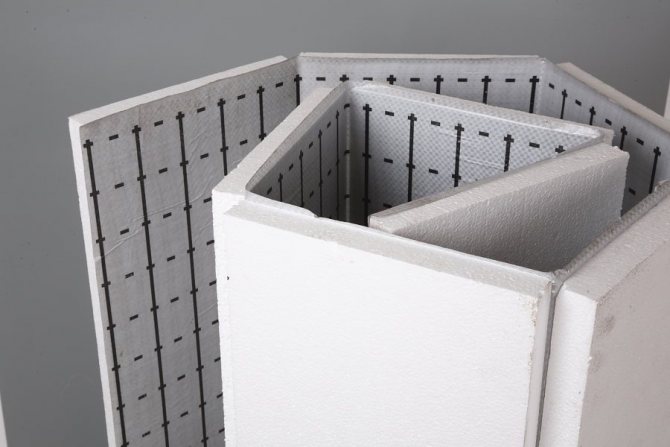

Foil polystyrene foam for thermal insulation of floors with markings.
Expanded polystyrene is the most suitable option for thermal insulation of floors.
This is due to a number of reasons:
- The material has a density sufficient for laying under a screed - more than 35 kg / m³;
- Expanded polystyrene plates have a sufficient thickness - 50 mm, thanks to which you can easily arrange an effective 100-mm thermal insulation of the floors of basements and basements, first floors, etc.;
- The material has a low thermal conductivity - 0.039 W / m × ° С, which, with a layer of 50 - 115 mm, gives complete insulation and reduces heat losses to nothing;
- Expanded polystyrene for floors is covered with a laminated foil layer from 30 microns thick, which makes this type of insulation optimal;
- The installation instructions assume simple do-it-yourself work, and the markings on the foil simplify the installation of heating elements;
- Plates do not shrink under the weight of the screed and maintain stable thermal conductivity values for many years;
- Polystyrene is chemically inert to solutions of salts, acids and alkalis;
- The material is biologically inactive and is not food for living organisms or a substrate for fungi;
- Does not change parameters and does not emit harmful chemicals in the temperature range from - 180 to +180 ° С.
Advice! When buying a heat insulator based on expanded polystyrene, look for exactly the floor material, since facade and other configurations may not be adapted to work near heating elements and emit harmful substances or change their parameters and shape.
Expanded polystyrene is especially convenient for warm water floors, if it is equipped with special locks for attaching pipes.
Important! According to most experts, it is extruded polystyrene foam with a density of 35 kg / m³ or more that is the best thermal insulation for warm floors, especially on basement floors and in the case of unheated rooms from below.
Thermal insulation for underfloor heating
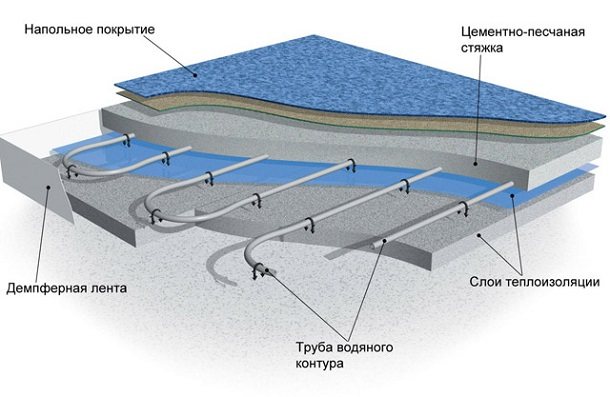

The modern market for heating systems offers ready-made heaters designed specifically for electric floors. Currently, there is a huge range of heat insulators on the market. But not all of them are suitable for underfloor heating.
Although, if you add some protective films or membranes to their use, then there will be much less problems with the choice. Manufacturers, on the other hand, approached this issue from a professional perspective. They make insulation specially designed for laying under a warm floor.
There are still few of them, but they meet all quality and safety standards:
- Penofol
It is a kind of foamed polyethylene foam. A reflective surface is the main requirement when choosing thermal insulation, since it is this surface that directs heat waves towards the ceiling.
- The material is devoid of any pores, dense enough to withstand heavy loads, and there are 4 types:
- The foil surface is on one side only.
- Both sides of the material are covered with a reflector.
- Self-adhesive has foil on one side, and special glue on the other.
- One side of the material is covered with plastic wrap and the other with foil.
- Extruded polystyrene foam (penoplex)
It is the most popular insulation for warm floors. This is due to its high strength and thermal insulation properties. Its structure does not change under the influence of high temperatures and does not emit harmful substances.
- Sheet cork
- It is the highest quality, natural, durable, environmentally friendly heat-insulating material. He:
- not subject to decay;
- fireproof;
- does not change its structure and volume when heated.
The only drawback of cork sheets is their high cost.
These are the main types of thermal insulation that can be laid even under a screed. Choosing one of them, you need to focus on indicators such as strength, sheet thickness, durability and thermal insulation properties.
Extruded polystyrene foam for underfloor heating
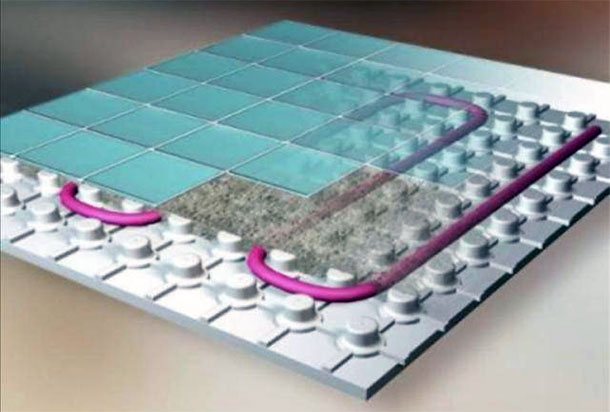

Extruded polystyrene is one of the best modern thermal insulation options. Its structure is uniform and consists of small closed cells with a size of 0.1-0.2 mm.
Extruded polystyrene foam is one of the derivatives of polystyrene obtained by mixing under high pressure at high temperatures of polystyrene granules and a blowing agent (carbon dioxide and freon mixtures).
Externally extruded polystyrene is a high strength rigid board with excellent thermal insulation properties.
The material began to be produced more than sixty years ago. And, despite this, today it can be called a universal insulation of all times and peoples.
One of its first advantages is a wide range of applications, both in civil and private construction.
- Here are the areas where extruded polystyrene is successfully replacing its counterparts:
- thermal insulation of foundations and basements;
- thermal insulation of floors;
- facade insulation;
- installation of "warm floors";
- wall insulation;
- thermal insulation of roofs;
- thermal insulation of pipelines and refrigerators;
- arrangement of walls and floors of basements;
- construction of partitions;
- warming the soil around the foundations, to prevent freezing.
- The second advantage of this material is its unique technical parameters:
- the lowest thermal conductivity among thermal insulation;
- high compressive strength;
- chemical resistance
- water and vapor tightness;
- resistance to mold and mildew formation;
- environmentally friendly material.
As a result of the tests carried out, it was proved that the characteristic properties of extruded polystyrene do not change as a result of repeated freezing and thawing. This makes this material almost ideal for the territory of Russia.
Today the construction market offers a wide range of these goods. The choice is yours. Here are just a few popular brands: Penoplex, Europlex, Technoplex and many others.
- For the basic foundation of our knowledge of extruded polystyrene, the rule comes in handy:
- for insulation of the 1st floor, the thickness of the slab must be at least 50 mm;
- everything above the first floor is in the range of 20-30 mm.
So, given this information about extruded polystyrene, you can correctly approach the choice of insulation for your floor.
Mats made of extruded polystyrene foam with shaped molded channels are, of course, cool and very convenient to install, but, unfortunately, they cost like an airplane wing.
Penoplex for underfloor heating
Penoplex is one of the best floor insulation materials due to its technical characteristics. The installation technology of such material is quite simple and does not have any nuances, therefore, laying the penoplex on the floor is possible even with your own hands.
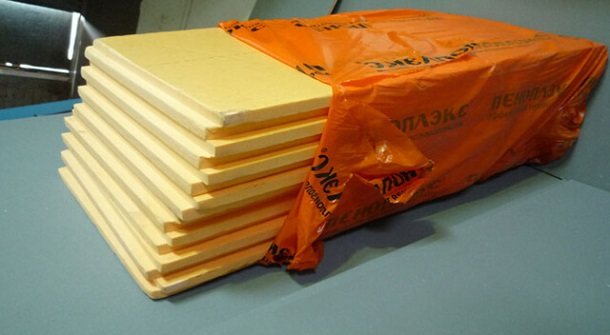

This type of insulation is produced in slabs with different thicknesses. The most common width is considered to be 600 mm, with a length of 1200 and 2400 mm. The thickness starts at 20 mm and ends at 100 mm. One package holds from 4 to 20 sheets, depending on their thickness.
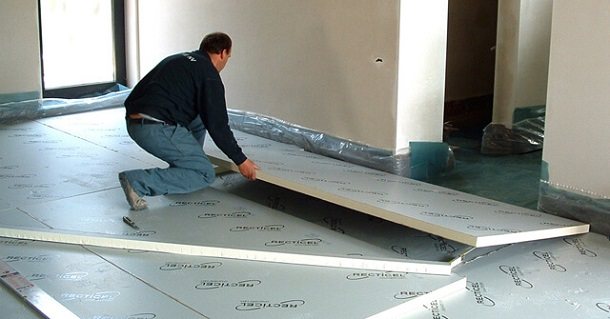

- The most important advantages include the following:
- does not absorb moisture at all;
- low thermal conductivity and vapor permeability;
- does not emit harmful substances;
- not afraid of microorganisms;
- high strength characteristics.
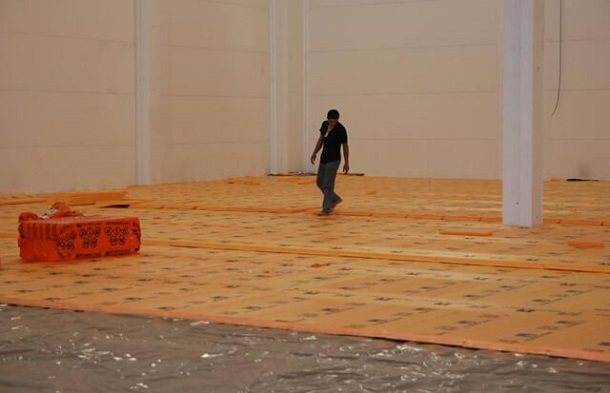

Properly laid penoplex on the floor under the screed will not allow cold, moisture, excessive noise to enter the room, it will be an excellent shield even in frosty weather. However, penoplex is afraid of solvents and high temperatures, and its price is quite high.
But, even in spite of this, the material is gaining more and more popularity among other heaters, replacing mineral wool and foam.
Penofol for underfloor heating
Penofol is a material made of foamed polyethylene, which simultaneously serves as a heat and vapor barrier. In addition, a layer of foil welded on top of the polyethylene reflects thermal radiation. The material has no pores, which means that it does not allow air to pass through and, therefore, imparts the properties of a thermos to the insulated structure.
Where can it come in handy? When insulating baths and saunas, which should store hot and humid air for as long as possible. Also cold floors, for example, a concrete base on the first floor of a building and a warm floor system.
Roll material made of polyethylene foam, on top of which a foil layer is applied. This is a reflective surface that repels heat rays from itself, thereby providing better heat transfer to the underfloor heating system.
The most important thing is that this insulation is quite dense and does not have pores in its body. This is a material that works like a thermos.
- Manufacturers currently offer four types of it:
- Type "A". The reflective foil surface is located on one side of the material.
- Type "B". A layer of foil is glued on both sides.
- Type "C". On one side, a reflective foil surface, on the other, an adhesive solution. This type is called self-adhesive.
- ALP type. Foil on one side, plastic wrap on the other.


Any of these types can be used as thermal insulation for a water or electric floor heating. It is important here to choose the right thickness of the material, which varies between 3-10 mm. The foil layer itself has a standard thickness of 100 microns.
Important. Please note that this insulation should be laid on the floors with the foil side up.
Now to the question of choice. The type and thickness of the heat insulator for underfloor heating is determined depending on the finishing material with which the floor base will be covered. For example, if it is decided to lay ceramic tiles on the floors, then cement-based tile adhesive will be used.
Everyone knows that cement is a chemically active material, under the influence of which some metals begin to corrode. Our aluminum foil is no exception.
But it was not in vain that manufacturers finished insulation for warm floors with a layer of 100 microns. This thickness allows you to withstand the reaction of the cement slurry, leaving part of the layer in full form.
Thick insulation on warm floors is usually used in rooms such as attached balconies and loggias, on terraces, in showers and bathrooms. Insulation of thinner thickness can be installed in other residential and office premises.
But in any case, insulation thickness is selected based on whether the screed has already been poured on the floors or not. If it is already poured, then, in order not to raise the surface too much and lower the ceilings, a thinner insulation is used.
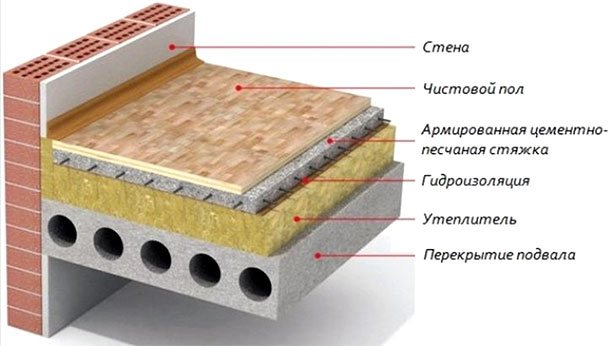

Thermal insulation for a warm floor of this type can withstand loads of 200 kg / m² and at the same time increases heat transfer up to 15%. Both indicators are excellent results. We also note that foil insulation for water and electric floors is the cheapest option. And this is another big plus.
Foam underfloor heating
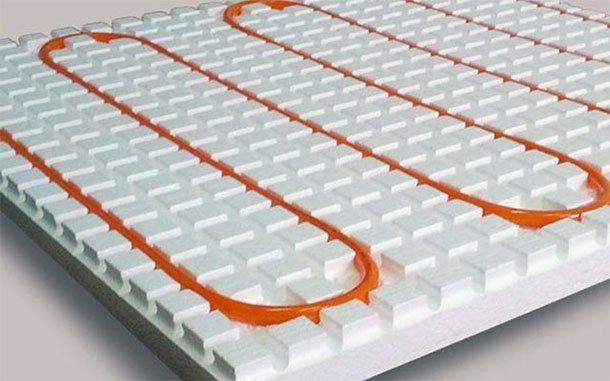

In rooms where the ceiling height reaches 260 centimeters and above, you can safely give preference to heaters based on a rigid polymer base. The basis for the manufacture of insulation boards can be polystyrene or expanded polystyrene.
The first version was created by a non-extrusion method, between its polymer cells there are channels for the passage of air and steam. Foam plastic has a low specific gravity, as well as high vapor permeability. In the manufacture of expanded polystyrene, the extrusion method is used, due to which the cells of the material are firmly sintered with walls to each other.
Because of this, the vapor permeability of the insulation is practically zero. But it has high strength and the ability to withstand significant mechanical stress. The specific heat capacity of expanded polystyrene is slightly higher than that of expanded polystyrene. In the first case, it is equal to 1.34 kJ / (kg ° C), in the second, it is calculated as 1.26 kJ / (kg ° C).
The difference is small, but when calculating it can significantly affect the overall thickness of the floor heating system. The standard size of Penoplex insulating sheets, for example, 120 cm × 240 cm. GOST number 15588-86 regulates the width from 50 cm to 130 cm, length from 90 cm to 500 cm.
The density of expanded polystyrene is 150 kg / m³, the same characteristic of foam is 125 kg / m³. Depending on the specifics of production and the properties put into the products by manufacturers, the characteristics of materials may vary.
If we compare both types of material, then the foam is disadvantageous in that it is inferior to the extrusion brother in terms of density. Due to this, it is less resistant to deformation under mechanical stress.
From this, its thermal insulation properties are significantly reduced. Polyfoam is recommended to be laid in the structures of the flooring systems between the joists.
How a water floor cake should look like in layers
The preparation of the cake under the floors must be carried out in strict accordance with the manufacturer's recommendation. Installation work is carried out as follows:
- Subfloor - the base must be level. The quality of the rest of the work depends on this. The cake can be laid on the floor slabs without pouring the rough screed.
- Thermal insulation - at this stage, the insulating layer is mounted. Profile mats made of polystyrene for laying a water heat-insulated floor are made with 1 by 0.5 m plates (the size depends on the manufacturer). But for greater convenience, you can order a single-piece plate of a larger size directly from the manufacturer. The plastic substrate for installation is laid exclusively on the leveled base. The design of the plastic system allows pouring the finishing concrete layer directly on top of the mats. The recommended thickness of expanded polystyrene insulation is at least 5 cm. The plates are fixed using special glue solutions, the locks at the joints are filled with polyurethane foam. Additionally, heat insulation is fastened using dowels "fungi".
- Reinforcing layer - laid only in the case of using a concrete system of underfloor heating. Lightweight polystyrene floor heating system does not need a reinforcing layer. Along the slabs, aluminum guides are laid, on top of which a water circuit is mounted. To increase the strength of the floor, plastic substrates are covered with slabs (DSP, GVL, etc.). A polystyrene floor withstands the same load as a cement screed, but weighs approximately three times less. A reinforcing mesh is necessarily laid on top of the usual insulation and, after laying the water circuit, it is poured with concrete.
- Finishing layer - any type of flooring is allowed. Modern systems allow laminate and linoleum to be laid. At the same time, it is recommended to comply with special operating rules.
Laying a warm water floor on mats, as shown by a comparison of thermal insulation materials (their technical characteristics and difficulties associated with installation), is more expedient. Permissible load on the polystyrene foam system 50 kN / m². The weight of the structure allows installation even in high-rise buildings on the last floors, where the use of a concrete cake is prohibited.
Additionally, the laminated extruded polystyrene foam with bosses is resistant to moisture, easy to install and facilitates the installation of the water circuit. The only drawback of polystyrene material is its cost. But if we take into account that plastic mats do not need additional components for fixing pipes, subsequent screed, then the difference in price becomes not so significant.
Features of laying insulation
When installing insulation, the types of mats used should be taken into account, since the nuances of laying the material depend on this:
- A foil substrate must be laid on top of the foam. A reinforcing mesh is laid, along which pipes are installed.
- The thickness of the mats varies from 5 to 10 cm. It is allowed that the thickness of the cork sheet backing is reduced to 2-3 mm.
- Insulation joints are glued with tape. The boards are fixed with anchor dowels and adhesive.
- The foil material is laid in such a way as to reflect heat in the best way, i.e. metal side up.
Some nuances of installation are indicated in the instruction manual. Strict adherence to the manufacturer's recommendations is the key to high heat transfer from heating using underfloor heating.
Styrofoam or polystyrene for the floor: make a choice
It is clear that underfloor heating is when the heating system is hidden under the floor. It should be noted that this system is not a new invention of our designers and builders. Even in the days of Ancient Rome, such a heating system was very popular. But for many centuries it was forgotten and is now remembered about it.
This floor heating system is very economical and comfortable for humans.Since the highest air temperature is at the floor surface, and the coldest air accumulates at the ceiling. With the currently adopted heating system - radiators - the air temperature distribution in the room is completely different. With a radiator heating system, the high temperature air is under the ceiling, and the coldest air is near the floor. If the room is still high, then even with good heating, the air near the floor will always be cool.
This is especially true for private houses or ground floor apartments, which are located immediately above the cold and damp basements.
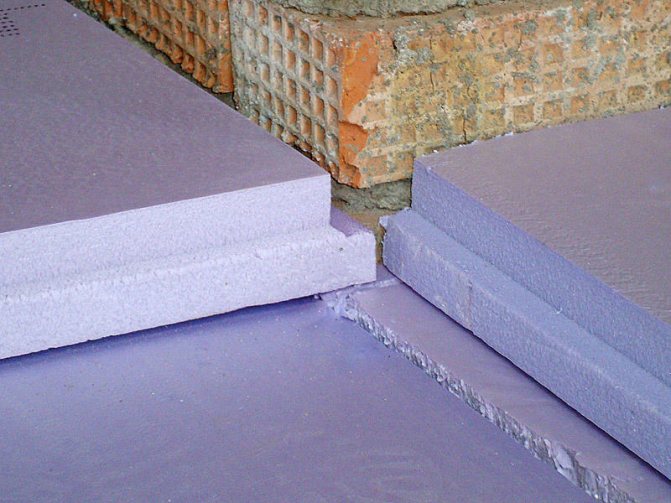

Penoplex has a denser structure and weighs more in comparison with foam
Heat-insulated floor is electric and water. The coolant in water is hot water, which flows through flexible pipes under the floor and heats the floor itself and the room. The water heating source can be a gas boiler. Such floors are most often arranged in private houses, since in apartments of multi-storey buildings, the device of such a system is extremely problematic, due to the possible breakthrough of pipes under the floor and further flooding of neighbors or the basement.
Technology for installing a water-heated floor:
- Floor cleaning - removing the old floor covering, removing the old screed;
- Rough screed device and leveling the floor with cement-sand mortar;
- After the rough screed has dried - laying the waterproofing film;
- The damper tape around the room is a heat insulator and compensates for thermal expansion.
Installation is simple, as the tape looks like a wide tape, it is simply glued. The installation of a heat insulator on bitumen mastic must be done with foam plates or you can choose foil polystyrene foam. Next, flexible heating pipes need to be fastened with special clips. The heating system must be connected to the boiler and the system must be tested - put hot water into the system. On top of the pipe, it is necessary to fill it with a special screed for underfloor heating. The ready-made cement mixture can be found in a special building materials store, and according to the instructions, prepare a cement screed. The thickness of the cement screed must be at least 4 cm. The screed will be ready only after 1 month. After that, you can glue sheets of plywood, ceramic tiles or lay a special laminate for warm floors. Most often, foam plates are produced in the size of 800x700x45. It should be noted that placing mats or rugs on top is not recommended as the temperature of the floor will decrease and the effectiveness of the floor will be low.
Overview of manufacturers and models
Mats for warm water floors are produced by many foreign and domestic companies. However, the leading positions are occupied by only four brands, whose products are in the greatest demand among buyers.
Heaters of the German Oventrop trademark have high quality and performance indicators. The model range includes profile mats with bosses, boards for dry laying, assembly roll and folding insulation in polypropylene film.


Plates with bosses have dimensions of 100 x 100 cm, they are available in two types: with thermal and sound insulating properties, as well as without thermal insulation
Another German manufacturer of thermal insulation is Rehau, whose mats are also attracting increased consumer interest. The main products are foam polystyrene mats with bosses, equipped with layers of thermal and sound insulation.
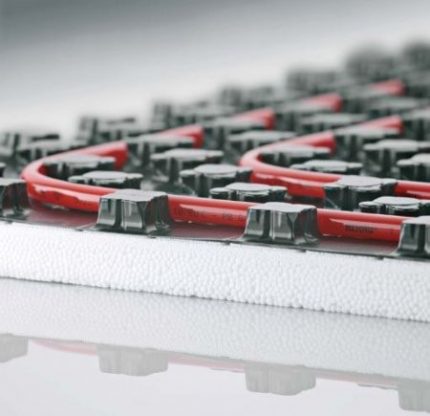

The slabs are 145 x 85 cm in size and are suitable for laying pipes with a diameter of 14 to 17 mm. The total thickness of the insulation is 50 mm. Supplied with pipe clamps
Among the Russian manufacturers, the most famous are the products of the Energoflex company.
The model line includes several items:
- foamed polystyrene boards;
- thin roll insulation with foil;
- expanded polystyrene plates with bosses.
All heat insulators have a grid with a pitch of 50 mm.
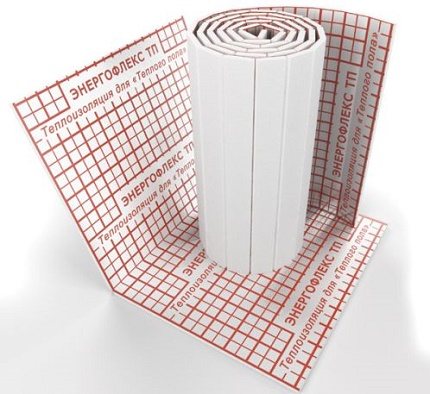

Foil plates are covered with a protective film, they are produced in the form of a roll or a book, have dimensions of 100 x 500 cm, the thickness of the insulation is 2.5 cm
Heaters for a water floor, produced by the Russian trade mark Ecopol, have excellent consumer and operational characteristics.
The manufacturer offers smooth expanded polystyrene boards and mats with lugs. The panels are provided with a lock joint and covered with a film waterproofing.
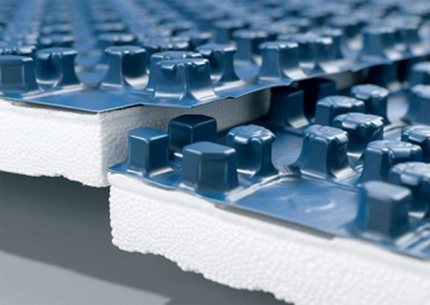

The mats are produced in three versions: with thermal insulation 20 and 30 mm and without thermal insulation. The dimensions of the slabs are 115 x 85 mm, the total thickness of the layers is 38 mm
Heat-resistant foil polystyrene foam
First you need to figure out what expanded polystyrene is - it is expanded polystyrene. It is made on special equipment, and it is quite simple that this building material itself is a cheap and affordable heat-insulating material.
Often polystyrene foam is also called polystyrene. In fact, these are the same polystyrene foam materials, with almost the same physical and chemical properties, but there are still differences.
All these building materials are insulation materials that are actively used in construction or renovation. But we will consider each material separately, realizing that there is a difference between them. Expanded polystyrene (this material is often called polystyrene) is not an official name. What is foam - it is the same polystyrene material as foam. Expanded polystyrene or polystyrene foam is expanded polystyrene, but without the use of pressing. In other words, the cells inside the material remain large and the density is low. The material is very fragile and breaks easily in hands. But it is very light and convenient and is needed in work - it can be easily cut with a knife. An excellent heat insulator, but this material is not suitable for floor insulation. It is often used when transporting fragile materials - household appliances, glass, mirrors, as well as when transporting long distances. It is produced in the form of plates or in the form of crumbs.


The main advantage of foil polystyrene foam is the environmental friendliness of the material
Recently, a novelty has appeared on sale - foil polystyrene foam. This is the same styrofoam, but covered with metal foil. It is produced in the form of a roll of 5 m long, 1 m wide and about 3 cm thick. The price is set for 1 m2, useful for installing a water-heated floor. The metal foil backing works to shield the heat that is emitted by the underfloor heating screed.
Advantages of foamed polystyrene foam:
- Heat insulator;
- Heat resistant to temperature extremes;
- Excellent sound insulator;
- Non-toxic when heated;
- Moisture resistant;
- Not subject to decay.
A roll of foil-clad expanded polystyrene is spread over the entire area of the room and fastened together with a sealant or a special pecking foil tape. This material has an excellent ability to save energy (heat, electricity). The fact is that 3 cm thick expanded polystyrene replaces 65 cm of brickwork or 125 cm of concrete for thermal insulation.
The use of expanded polystyrene for thermal insulation of wooden floors
on logs with extruded polystyrene foam includes the following activities:
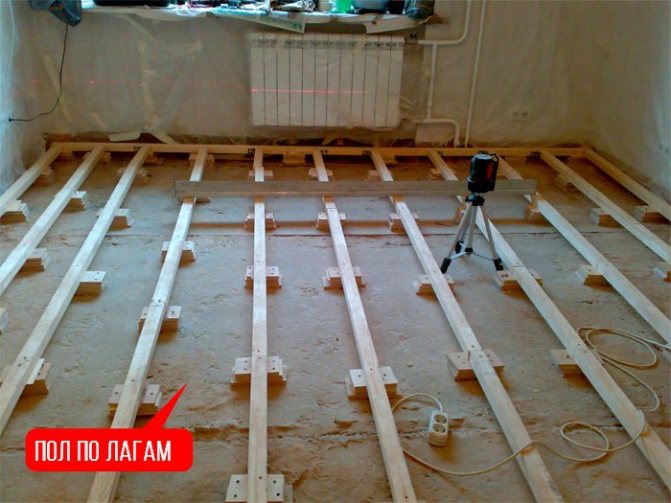

- Dismantling skirting boards and existing flooring;
- Inspection of the elements of the wooden system, repair and replacement, if necessary, of rotten parts of the support bar, log and rough flooring;
- Impregnation with fire retardant and antibacterial solutions of all areas of wood;
- Installation of a waterproofing layer. A polyethylene or foil film is placed between the logs, while the edges should go to the ends of the log and the side surface of the walls by 10 - 15 cm.
- Plates of expanded polystyrene make an insulating layer between the logs on top of the rough flooring, connecting them to each other with grooved ends. Gaps and slots are filled with polyurethane foam or special glue with pieces of expanded polystyrene;
- The device of a vapor barrier layer. Cloths of a profiled membrane or a dense polyethylene film are laid with an overlap, the size of which is 15 - 20 cm, and fixed to the logs with construction tape. Seams and edges are glued with special adhesive tape.
- Re-assembly in a wooden house of a boardwalk, the floorboard of which is pre-impregnated with a fire retardant and antiseptic compound.
Insulation of the floor along the logs can also be performed with a cheaper material - polystyrene, since the main load in this case will fall on the wooden structural elements.
Article Rating
